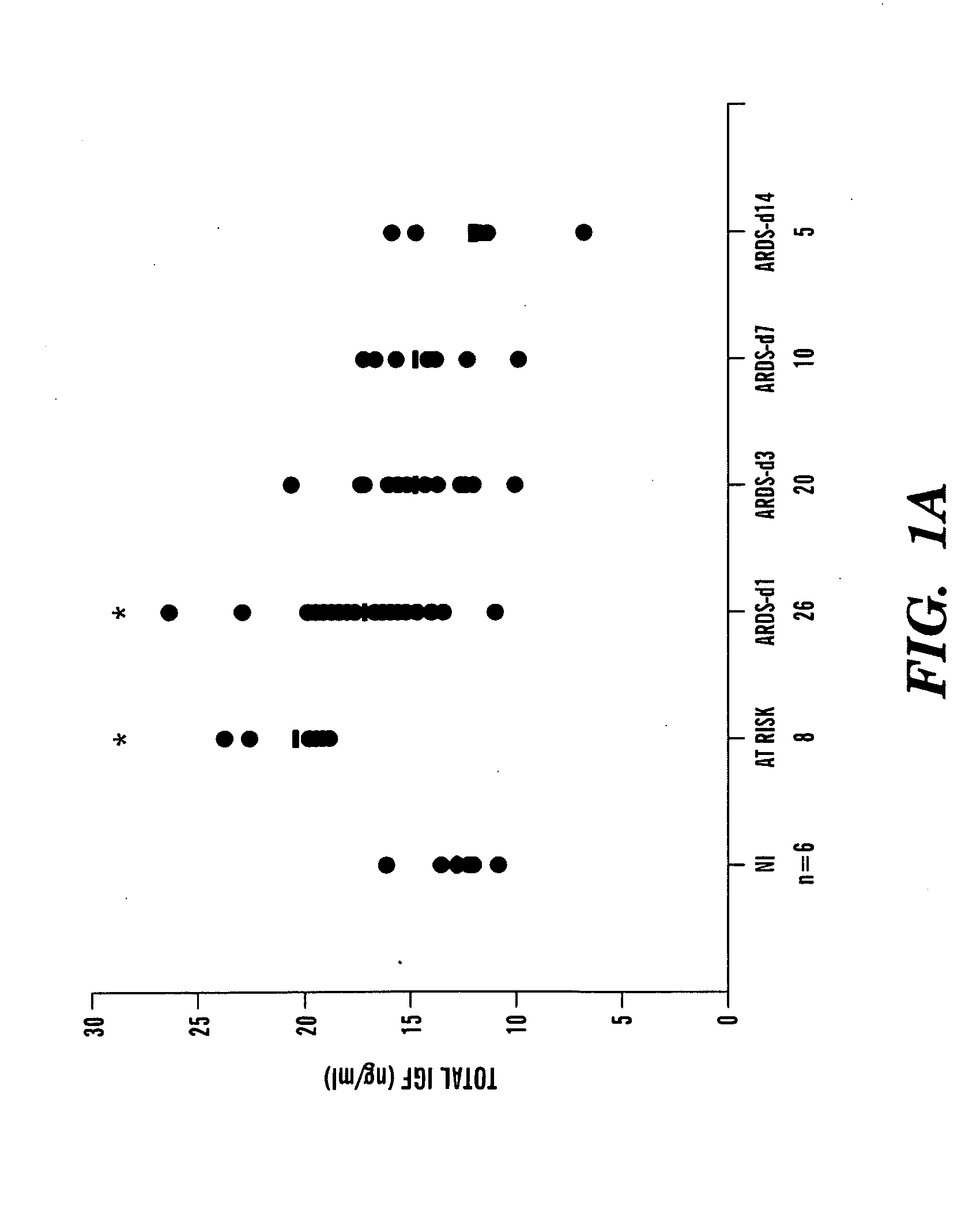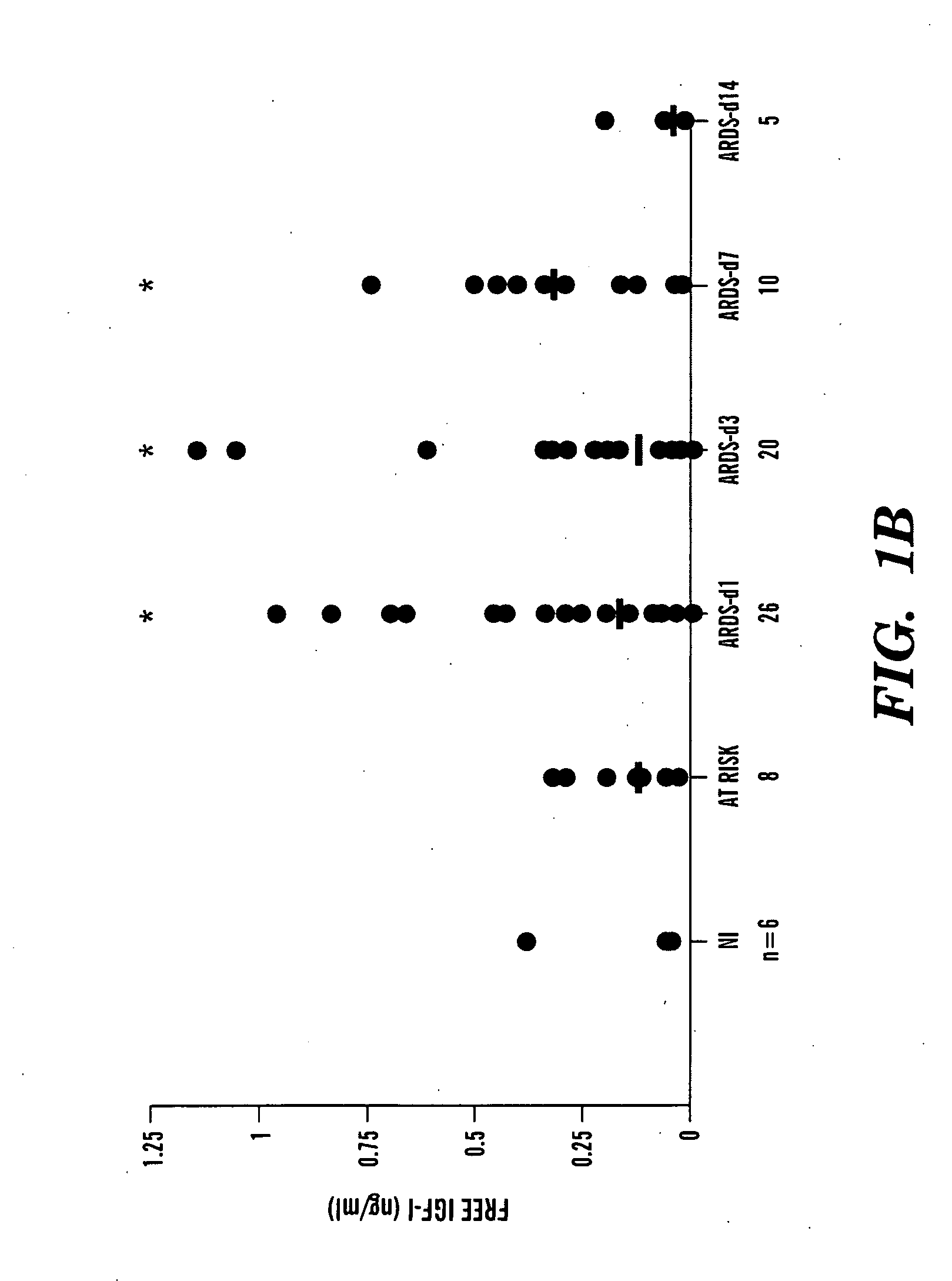Compositions and methods for the treatment of respiratory disorders
a technology for respiratory disorders and compositions, applied in the field of respiratory disorders, can solve the problems of inability to take into account, inability to accurately predict the outcome, and inability to identify single protein markers by traditional laboratory methods, and achieve the specificity or sensitivity to serve as a reliable predictor of outcom
- Summary
- Abstract
- Description
- Claims
- Application Information
AI Technical Summary
Benefits of technology
Problems solved by technology
Method used
Image
Examples
example 1
Identification of a Role for the IGF Pathway in ARDS
[0219]To obtain a more complete protein profile of the airspace milieu in acute respiratory distress syndrome (ARDS) and to identify new mediators, bronchoalveolar lavage fluid (BALF) was analyzed by shotgun proteomics. Using BALF from three patients, a total of 870 different proteins were identified, a nearly 10-fold increase from previous reports. Among the proteins identified were known markers of lung injury, such as surfactant, proteases, and serum proteins. Also identified were several biologically interesting proteins not previously identified in patients with ARDS, including insulin-like growth factor-binding protein-3 (IGFBP-3). Because of the known role of IGFBP-3 in regulating cell survival, IGFBP-3 levels were measured by enzyme-linked immunosorbent assay in ARDS BALF. Normal controls had low levels of IGFBP-3, whereas patients with early ARDS had a significant increase in IGFBP-3. The IGF pathway, acting through the ty...
example 2
[0221]The protocol was approved by the Institutional Review Board, University of Washington. Written informed consent was obtained from the patient or responsible relative before patients were entered into the study. Patients with acute lung injury undergoing bronchoscopy for suspected ventilator-associated pneumonia were included in the study as the initial index patients (Table 1).
TABLE 1Clinical Characteristics of ARDS PatientsIndex patients*Retrospective CohortAtARDS123RisksummaryDay 1Day 3Day 7Day 14Age28495947 ± 1543 ± 16Risk FactorSepsisYes323TraumaYes525OtherYes013Apache score16222019 ± 8 22 ± 7 22 ± 6 21 ± 9 23 ± 819 ± 3 PaO2 / FiO2184 271 290 226 ± 83 162 ± 61 151 ± 55 162 ± 58 189 ± 71178 ± 43 Static compliancendndnd40 ± 1037 ± 1341 ± 1537 ± 1928 ± 935 ± 17% BAL volume38713357 ± 1150 ± 1454 ± 1250 ± 15 43 ± 1144 ± 19recoveredVAP?NoYesNo*None of the index patients had a diagnosis of pneumonia as a risk factor for acute lung.
[0222]In addition, specimens obta...
example 3
Peptide Separation and Purification
[0224]BALF proteins were concentrated by ice-cold acetone precipitation. BALF containing 2 mg of protein underwent digestion with trypsin (20 μg, sequencing grade; Promega, Madison, Wis.) overnight at 37° C. to allow complete digestion. To prepare for strong-cation exchange chromatography and to reduce the salt concentration, the resulting peptide solutions were diluted eightfold with running buffer (5 mmol / L KH2PO4, 25% acetonitrile, pH 3), and their pH was reduced to ˜2.9 with phosphoric acid (H3PO4). The peptide solutions were passed over a 2.1×200 mm, 5-μm particle, 300-Å pore Polysulfoethyl A column (PolyLC; Columbia, Md.), washed with running buffer, and then eluted with a 50-minute biphasic gradient of 0 to 25% elution buffer (running buffer plus 350 mmol / L potassium chloride) in 0 to 30 minutes followed by 25 to 100% elution buffer in 30 to 50 minutes. Flow rate was constant at 0.2 ml / minute. Sixteen 2-minute (0.4-ml) fractions were collect...
PUM
| Property | Measurement | Unit |
|---|---|---|
| Composition | aaaaa | aaaaa |
| Pharmaceutically acceptable | aaaaa | aaaaa |
Abstract
Description
Claims
Application Information
 Login to View More
Login to View More - R&D
- Intellectual Property
- Life Sciences
- Materials
- Tech Scout
- Unparalleled Data Quality
- Higher Quality Content
- 60% Fewer Hallucinations
Browse by: Latest US Patents, China's latest patents, Technical Efficacy Thesaurus, Application Domain, Technology Topic, Popular Technical Reports.
© 2025 PatSnap. All rights reserved.Legal|Privacy policy|Modern Slavery Act Transparency Statement|Sitemap|About US| Contact US: help@patsnap.com



